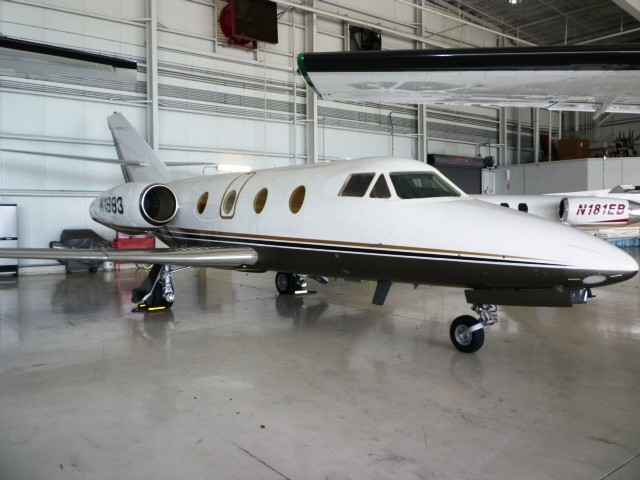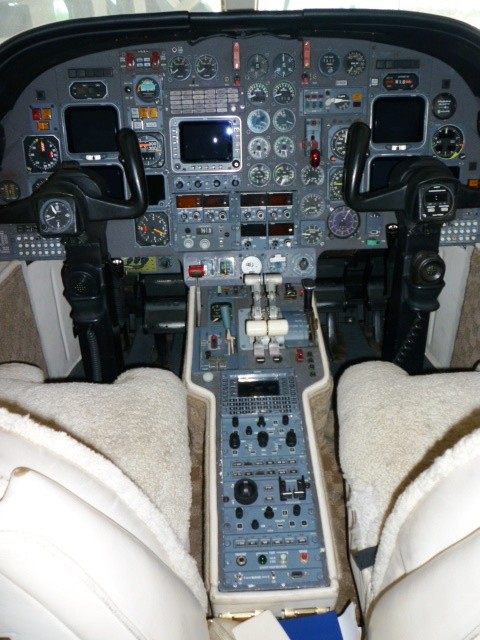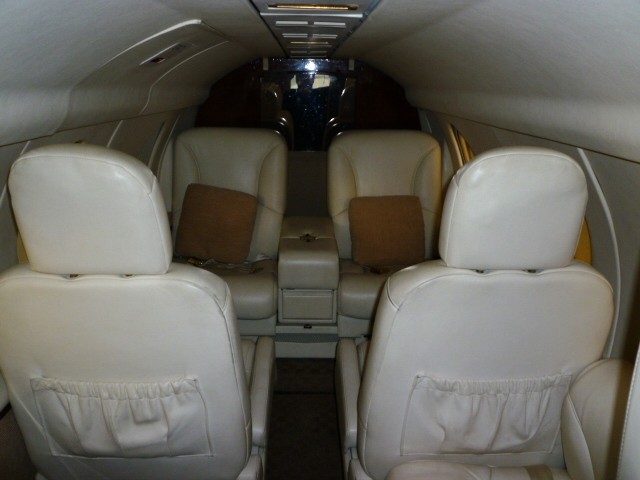


Aircraft Description
Background/History
The Falcon 10 design was undertaken by Dassault in the late 1960s in order to fill a gap between the company’s Falcon 20 and the turboprop aircraft that made up the next smaller group of cabin-class business aircraft. The Falcon 10 was originally powered by two General Electric CJ610 turbojet engines when it first flew in December 1970. However, Pan Am Business Jets Division which placed the first order for the new type, required that turbofan engines be installed. The GE engines were subsequently replaced by a pair of Garrett TFE 731-2 turbofans on the second prototype, and this configuration won FAA certification in 1973, with first deliveries beginning soon thereafter. In 1983, a series of design refinements culminated in the re-designation of the aircraft as the Falcon 100. Changes included an optional early EFIS glass cockpit, a higher maximum takeoff weight, a fourth cabin window on the starboard side and a larger unpressurized rear baggage compartment. When the line was discontinued in 1989, combined production of the Falcon 10 and 100 series totaled 226 units, with 37 of these the Falcon 100 variant.
Power
The Falcon 100 is powered by a pair of Honeywell TFE 731-2-1C turbofan engines rated at 3,230lbs. of thrust each. Inspection interval on the engine core is 4,200 hours.
Avionics
The Falcon 100, a Falcon 10 with an exterior-access luggage hold and an improved cabin, was the first certified business aircraft featuring EFIS-technology and color screens in the place of electromechanical cockpit instruments. A typical avionics package on a Falcon 100 could include dual Collins VHF 20A comms, dual VIR 30A navs, dual Collins FCS 85 flight directors, dual Collins DME 42, dual Collins ADF 60A, ALT-55 radar altimeter, Collins APS 80 autopilot, Collins ADS 80 air data computer, Global GNS-XLS FMS, Sperry Primus 400 color weather radar. Some Falcon 100s also feature the Collins EFIS 85, five-tube panel.
Design Features
The Falcon 100 is a light, medium-range, twin turbofan-powered business jet configured as a cantilever, swept low-wing monoplane with a swept cruciform tail. The airframe is of aluminum monocoque construction. The wing utilizes a supercritical airfoil optimized for cruise at high subsonic speeds and is equipped with wide-span double-slotted flaps and full leading-edge slats to improve low-speed handling characteristics. The retractable tricycle landing gear has dual wheels on each main mount and a single nose wheel. Refueling can be accomplished from a single point near the right engine nacelle, or gravity fueling can be done over-wing into each tank if desired.
Accomodations
The interior of the Falcon 100 is normally configured to seat four passengers in an executive-club seating arrangement, with seating for six in a high density layout. A lavatory seat is located toward the front of the cabin along the starboard sidewall. Baggage storage is aft behind a rear bench seat, if installed, and is accessable only from the inside. The aircraft cabin can also be adapted to air ambulance and light utility configurations. Cabin dimensions are 12.9ft.in length, 4.8ft. in height and 5ft. in width.
| General | Falcon 100, DA-100 | |||
|---|---|---|---|---|
| Category | Jet < 20,000 lbs. | |||
| Years Aircraft Manufactured | 1982 – 1990 | |||
| Serial Number Range | 183 – 226 | |||
| Retail High Price | $1,450,000.00 / 1,137,815.00€ | |||
| Retail Low Price | $795,000.00 / 623,836.50€ | |||
| Characteristics | Falcon 100, DA-100 | |||
| Seating | 2 + 6/9 | |||
| Wing Loading | 72.2 | |||
| Power Loading | 2.9 | |||
| Noise(EPNdB): Takeoff/Sideline/Approach | 83.4/95.4 | |||
| External Dimensions (ft) | Falcon 100, DA-100 | |||
| External Length | 42.8 | |||
| External Height | 15.2 | |||
| External Span | 42.8 | |||
| Internal Dimensions (ft) | Falcon 100, DA-100 | |||
| Internal Length (Overall/Net Height) | 12.9 | |||
| Internal Height | 4.8 | |||
| Internal Width (Max/Floor) | 5.0 | |||
| Baggage | Falcon 100, DA-100 | |||
| External: Cu.Ft./Lb. | N/A | |||
| External: Cu.Ft./Lb. | N/A | |||
| Power | Falcon 100, DA-100 | |||
| Engines | 2 Hon TFE731-2-1C | |||
| Output (lbs ea.)/Flat Rating | 3,230 | |||
| Inspection Interval | 4,200c | |||
| Data based on latest manufactured year | ||||



